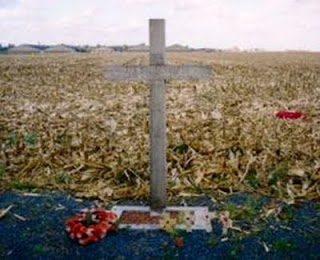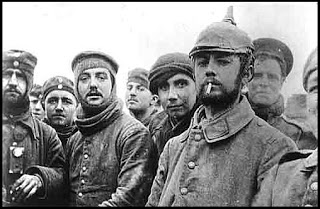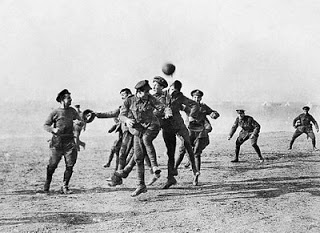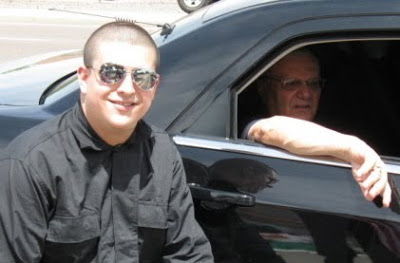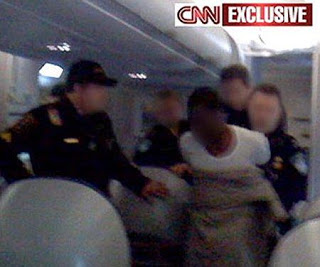
"Ahem -- yeah, well, we'll take it from here": Government security personnel take suspected terrorist Umar Farouk Abdelmutallab into custody in Detroit after passengers did all the hard stuff -- subduing him when his "lap bomb" failed to detonate and extinguishing the incendiary device.
You know, Chief, this nude bomb might solve a lot of problems. For one thing, flashers.... And there'd be no more trouble with concealed weapons. I mean, if everyone were nude, there'd be no place to hide a gun or knife. Well, there is a place, but it could be painful.
Maxwell Smart, the redoubtable Agent 86, finding the upside to KAOS's terrorist threat to destroy the world's clothing with its dreaded Nude Bomb.*
In an utterly predictable response to an unsuccessful attempt by a would-be Jihadist to emasculate himself in mid-air by detonating a small explosive charge (a very small one, of course), the Regime is moving, slowly but inexorably, in the direction of requiring airline passengers to strip nude.
There is plentiful evidence to suggest that the same Regime acted as an accomplice -- most likely a passive one -- in that same failed bombing attempt. Call it a delayed-action nude bomb: One Nigerian nutcase conceals a firecracker in his wedding tackle, and before long everybody will have to strip nude in order to fly.
Granted, the nudity would be "virtual," temporary, and limited in its exposure. Passengers would be violated one at a time by the same thoughtful people who have made a career out of rifling through other people's dirty underwear.
Airport security screeners have "got to have some way of detecting things in parts of the body that aren't easy to get at," insists former Homeland Security Commissar Michael Chertoff. "It's either pat-downs or imaging."
A third alternative is to avoid commercial aviation outright whenever possible. I suspect an ever-larger number of Americans are going to join me in choosing what's behind door number three.
Government is the only human enterprise that profits from failure. Once that principle is understood, many otherwise inexplicable choices made by ruling elites and their servants can be made intelligible.
For instance, we can begin to understand the perverse persistence governments display in courting preventable catastrophes, and then capitalizing on such incidents to enhance their powers to do exactly the same things that resulted in disaster. In this case, in addition to requiring the helotry to undergo unconscionable personal violations before flying, the Regime is exploiting the incident aboard Northwest Flight 253 to escalate the ongoing military assault on Yemen, thereby increasing the human misery that helps propel international terrorism.
And so it is that the Regime -- which has squandered trillions of debased dollars in the name of "fighting terrorism" (hundreds of billions to build a domestic garrison state, and even greater sums to conduct wars of aggression overseas) -- will continue to do exactly the same thing following an episode that demonstrates, beyond serious dispute, that the "war on terror" has done exactly nothing to make Americans safer.
While it's not clear that the flight was in mortal danger, it is clear that the plot failed because a detonator failed to ignite, and a group of passengers shed the shackles of government-imposed docility to subdue the terrorist suspect. The attempt to massacre the passengers of Flight 253 was stopped without the Regime's help -- and in spite of what has to be considered, at very best, the Regime's criminal negligence.
 Umar Mutallab as a student in London (left); his father, Nigerian banking official Umar Mutallab the elder (below, right).
Umar Mutallab as a student in London (left); his father, Nigerian banking official Umar Mutallab the elder (below, right). Owing to what must have been an anguished report from his father, Umar Abdulmutallab was known to the CIA and the State Department as a potential terrorist. Umar Mutallab the elder, a banking official from Nigeria, met personally with CIA officials to express concerns that his son -- who had gone to Yemen for the supposed purpose of studying Arabic -- was falling into the company of suspected terrorists.
U.S. officials took this valuable intelligence and promptly buried Abdulmutallab's name in an official database. Yet it was not placed on the official "no-fly list"; apparently, that status is reserved for people who make themselves troublesome to the Executive Branch without actually posing a threat to innocent people.
Additional layers of official negligence were revealed by a passenger named Kurt Haskell, who was next to Abdumutallab as the would-be bomber checked in at the airport in Amsterdam:
Haskell also says that he stood a few yards away from another Indian man who was handcuffed and held in customs "after a bomb sniffing dog detected a bomb in his carry on bag and he was searched after we landed. This was later confirmed while we were in customs when an FBI agent said to us `You are being moved to another area because this area is not safe. Read between the lines. Some of you saw what just happened.'.... What also didn't make the news is that we were held on the plane for 20 minutes AFTER IT LANDED!. A bomb could have gone off then. This wasn't too smart of security to not let us off the plane immediately."
Assuming that Haskell's account is correct, Abdulmutallab received some variety of official help to board the plane, and may have been part of a team of bombers. The reported connection to India is of particular interest, given a growing dispute between Mumbai and Washington over a Pakistani-born U.S. citizen allegedly involved in the 2008 terrorist rampage at the Taj Mahal Hotel that left 166 people dead.
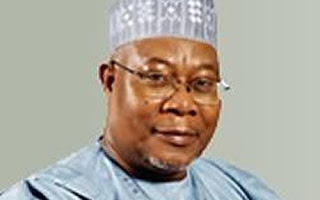 David Headley (nee Daood Syed Ginlani; he changed his name in 2006) moved from Pakistan to Philadelphia in 1977.
David Headley (nee Daood Syed Ginlani; he changed his name in 2006) moved from Pakistan to Philadelphia in 1977.After being convicted of heroin smuggling in 1998, Ginlani served 15 months before agreeing to work as an informant for the DEA. Indian officials believe that Headley/Ginlani was working for the federal government -- the CIA and FBI, in addition to the DEA -- up until last October, when he was arrested in Chicago.
Indian officials accuse Headley of working with Pakistan's ISI intelligence agency in coordinating the Taj Mahal Hotel assault. They also assert that in a return trip to India last March, Headley cased potential targets for another terrorist attack by the Lashkar-e-Taiba ("Army of the Pure"), a Pakistani terrorist group. Indian officials are desperate to question Headley, but Washington refuses to grant access.
After wading in the tenebrous waters of the global "intelligence community," brief recap is appropriate here:
The CIA was informed that Abdumutallab was a potential terrorist. Yet he wasn't put on the "no-fly list," and was even permitted to board a U.S.-bound plane without a passport. The individual who reportedly shepherded the bomber aboard the plane was a well-dressed, official-looking fellow from India. After Flight 253 landed in Detroit, a second individual from India was arrested after a bomb was detected in his luggage. All of this happens a little more than a year after India suffered an horrific terrorist attack in which (according to both U.S. and Indian intelligence officials) an American intelligence asset named David Headley was implicated. Headley is in the custody of the government that employed him as an informant, and which now refuses to permit investigators representing a supposed ally to interrogate him.
Those of a cynical cast of mind might wonder if RAW (the Research and Analysis Wing, India's CIA) had helped Abdumutallab hitch a ride on Flight 253 in order to send a message to Langley. Those whose cynicism is a bit riper might wonder if the boys at Langley had become aware of the plot involving Abdumutallab and permitted it to go forward in the service of Washington's agenda -- which includes escalating a previously covert military campaign in Yemen, the country where the jockstrap bomber reportedly was tutored in terrorism by al-Qaeda.
Whenever somebody ventures into conspiratorial speculation of this kind he can expect a reminder from the bien-pensants that government is too inept to carry out secret schemes of such detail and complexity.
Dismissive arguments of that kind generally come from people who are quite convinced of the ability of that same incompetent government to carry out very challenging undertakings, such as running a nationalized health-care system, or creating western-style democracy in Iraq.
While it is true that government is incurably incompetent with respect to any genuinely worthwhile productive enterprise, it is an astonishingly efficient engine of plunder and destruction. However useless the CIA and its kindred agencies may be in collecting and analyzing reliable intelligence, they display considerable gifts when it comes to arranging politically useful mischief.
One useful case study that bears more than a passing resemblance to the abortive bombing of Flight 253 in the plot to carry out a bombing rampage in New York City following the first World Trade Center attack in 1993.
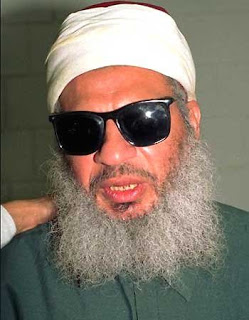
Omar Abdel-Rahman, the radical Egyptian mullah who was convicted in 1996 of inspiring and giving direction to that plot, became a CIA asset in 1987, despite the fact that he was on a State Department terrorist "watch list."
Abdel-Rahman's role was to recruit mujahadeen to fight the Soviets in Afghanistan, and to act as a cut-out to provide them with financial and material aid. He remained on the CIA's payroll after the Red Army left Afghanistan in January 1989.
In 1990, Abdel-Rahman obtained a visa to travel to the United States -- once again, despite the fact that his name was on a "watch list." It was his monumental good fortune to apply for that visa at the U.S. consulate in Khartoum while the official who usually handles such details was out to lunch; that official's replacement was a CIA operative.
Abdel-Rahman's relocation to Brooklyn was arranged by a small knot of radicals who included at least two people who were on Washington's payroll: Mahmoud Abouhalima, a member of the Muslim Brotherhood (the taproot of modern Islamic terrorism and -- not surprisingly -- a major beneficiary of CIA largesse) who had been part of a CIA-sponsored mujahadeen group in Afghanistan; and former Special Forces Captain Ali A. Mohammed, an Egyptian-born member of Islamic Jihad who had recruited and trained Muslim warriors to fight in Afghanistan.
Mohammed, it was later revealed, also worked as an informant for the FBI. It's not clear if he was on the Bureau's payroll at the time of the 1993 WTC bombing. If so, that means that there were two FBI assets within that cell -- Mohammed and an Egyptian intelligence agent named Emad Salem.
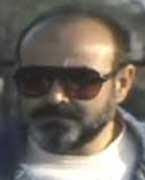
Although the January 1993 WTC bombing failed to achieve its objective -- which was to collapse one of the towers into the other, creating a domino effect that would have slaughtered thousands -- the assault did kill several people and injure hundreds more.
Salem, who secretly recorded many of his conversations with his FBI handlers, later revealed that the FBI had detailed prior knowledge of that plot and had promised him that the WTC bomb would secretly be rendered inert before it was used.
"You saw this bomb went off ... and you know that we could avoid that," Salem rebuked FBI special agent John Anticev following the blast. "You get paid, guys, to prevent things like this from happening."
 How many federal assets does it take to build a terrorist bomb? There are at least two in this picture. One of them, Egyptian intelligence agent/FBI informant Emad Salem, is the figure in green with his back to the camera.
How many federal assets does it take to build a terrorist bomb? There are at least two in this picture. One of them, Egyptian intelligence agent/FBI informant Emad Salem, is the figure in green with his back to the camera. After the bombing, the FBI inserted Salem into the cell once again. In that capacity he helped create a "battle plan" that targeted various official buildings in New York City, as well as the Holland and London tunnels.
On June 23, 1993, FBI agents arrested the plotters as they were mixing fertilizer and diesel fuel to build another bomb.
This story (which I have recounted in greater detail elsewhere) took a really interesting turn just shortly before Abdel-Rahman's trial. Ali Mohammed, who played a central role in the first WTC attack, was listed as an "un-indicted co-conspirator" with Abdel-Rahman. Roger Stavis, the attorney for indicted co-conspirator El Sayyd Nosair, attempted without success to deliver a subpoena to Mohammed as a defense witness. Mohammed -- who was in federal custody -- didn't answer the summons.
In March 2001, Mohammed pleaded guilty -- in exchange for "considerations" -- to charges arising from the 1998 bombings of U.S. embassies in Kenya and Tanzania, which killed 258 people. He then promptly disappeared without being sentenced.
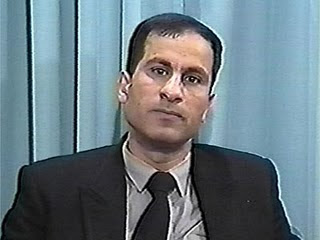 Intelligence analyst J.M. Berger, publisher of the valuable Intelwire news service, points out that U.S. Attorney Patrick Fitzgerald, who was considered the Justice Department's "top gun" on al-Qaeda, regarded Mohammed as the architect of "al Qaeda's terrorist infrastructure in the U.S."
Intelligence analyst J.M. Berger, publisher of the valuable Intelwire news service, points out that U.S. Attorney Patrick Fitzgerald, who was considered the Justice Department's "top gun" on al-Qaeda, regarded Mohammed as the architect of "al Qaeda's terrorist infrastructure in the U.S."On the basis of his extensive study of the available evidence, Berger concludes that Mohammed "called the shots" on the 1993 WTC bombing -- the man behind Ramzi Yousef, the individual convicted of building the bomb -- and was the most important organizer of the network behind the 9/11 assault.
And Mohammed -- a former U.S. Special Forces sergeant and FBI asset -- is being protected by the Regime to this day.
Many serious and sober people believe that the accepted narrative of the 9/11 atrocities is entirely fictitious. But in light of the role played by veteran U.S. asset Ali Mohammed, it's incontestable that the attack was, in some sense, an "inside job" even if one accepts the standard "nineteen Muslims armed with boxcutters" version of the event.
According to the Regime, Abdulmuttab is telling his interrogators that there are many more mad bombers in the pipeline. This is probably true, and it's likely that at least some, if not most, of them have cashed checks written by the same people who hired the likes of Adbel-Rahman and Ali Mohammed.
False-flag terrorism is among the oldest tricks in the intelligence playbook. It has been an official option of the military-industrial-homeland security complex since 1962, when General Lyman Louis Lemnitzer, Chairman of the Joint Chiefs of Staff, filed the "Operation Northwoods" memorandum outlining various elaborate schemes to stage terrorist attacks against Americans as pretexts for war.
It's doubtful that this side of eternity we'll ever learn the full truth about 9/11 or the first World Trade Center bombing. But we have learned enough from those atrocities, as well as subsequent episodes of what Lew Rockwell aptly calls "security theater," to justify suspicions that the Christmas drama aboard Flight 253 was another example of what Maxwell Smart, the patron saint of self-important spooks, would call the old "False-Flag Trick."
___
*Yes, I'm aware that this quote comes from the dismal, vulgar, and lifeless 1980 film The Nude Bomb, which discerning Smartians consider apocryphal at best.
 Be sure to tune in for Pro Libertate Radio each weeknight from 6:00-7:00 Mountain Time (7:00-8:00 Central) on the Liberty News Radio Network.
Be sure to tune in for Pro Libertate Radio each weeknight from 6:00-7:00 Mountain Time (7:00-8:00 Central) on the Liberty News Radio Network. Dum spiro, pugno!

